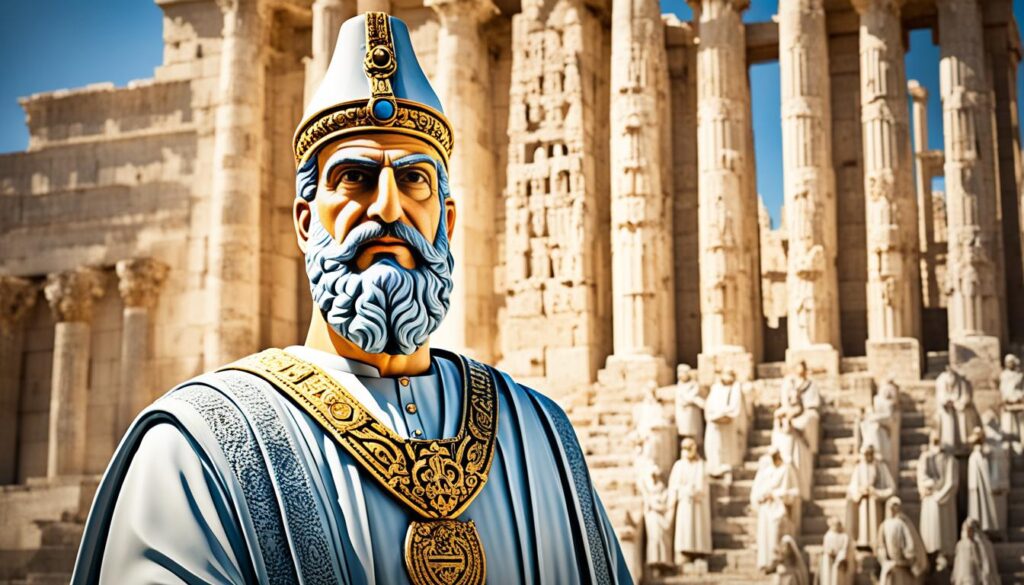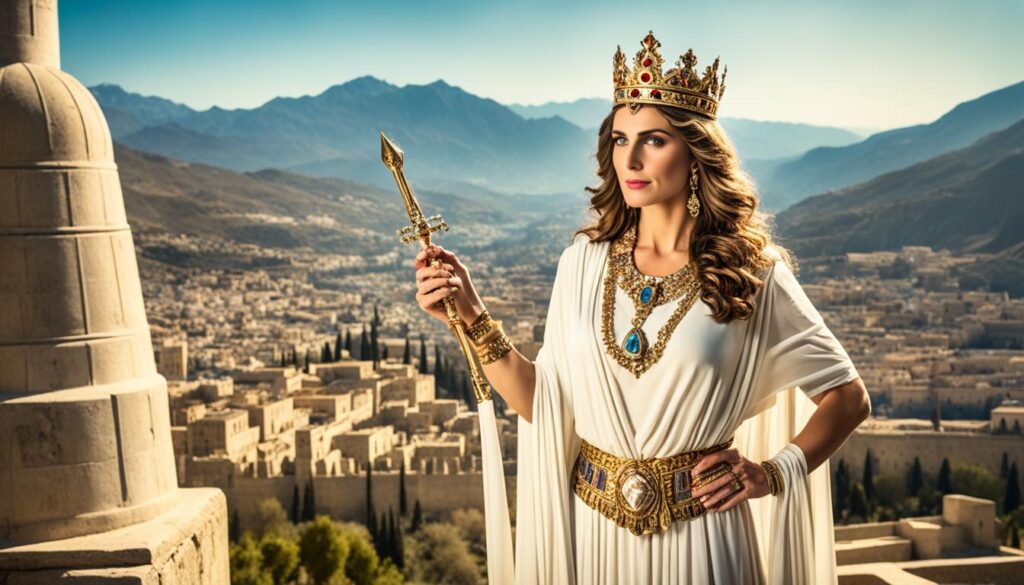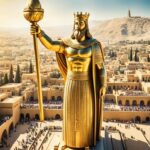King Artaxerxes, a prominent figure in Persian history, holds great significance in the Bible. Mentioned in the Old Testament books of Ezra, Nehemiah, and Daniel, his reign witnessed transformative events and shaped the lives of biblical characters. Through his rule, Jerusalem was rebuilt, religious reforms were implemented, and the Judean society experienced the influence of the Persian empire.
Key Takeaways
- Artaxerxes played a crucial role in the rebuilding of Jerusalem after the Babylonian exile.
- His reign introduced religious reforms that influenced the development of the Second Temple and Hebrew Bible.
- Esther, a central biblical character, became queen of Persia during Artaxerxes’ reign.
- Persian influence significantly impacted Judean history during Artaxerxes’ rule.
- King Artaxerxes’ biblical legacy showcases the intertwining of political power and religious faith.
The Rebuilding of Jerusalem under King Artaxerxes
During the reign of King Artaxerxes, a pivotal moment in Jewish history unfolded as Jerusalem’s walls, which were destroyed by the Babylonians, were rebuilt. Artaxerxes’ decree enabled the restoration of this significant city, laying the foundations for a new chapter in the Judean society.
“Artaxerxes, king of kings, to Ezra the priest, the scribe of the Law of the God of heaven… I issue a decree that anyone who belongs to the people of Israel, including priests and Levites in my realm, may go up to Jerusalem with you.”
Under Artaxerxes’ rule, he not only provided resources and protection for the rebuilding project but also granted permission for the exiled Jews to return to Jerusalem. This decree served as a turning point, marking the end of the Babylonian exile and the start of the restoration of Jerusalem’s prominence.
With the support of King Artaxerxes, the Judean community embarked on the arduous task of reconstructing the city’s walls. This monumental endeavor aimed to reinforce the security and integrity of Jerusalem, ensuring its safeguard against potential external threats.
The rebuilding of Jerusalem not only had political and strategic implications but also carried deep spiritual and cultural significance for the returning exiles. It symbolized the restoration of their homeland and the revival of their national identity, reinforcing their connection to their faith and heritage.
Impact and Significance
The rebuilding of Jerusalem under King Artaxerxes’ reign laid the groundwork for the reestablishment of the Judean society and its religious practices. The restored walls and the return of the exiled Jews marked a revival of the city’s spiritual life and the subsequent development of the Second Temple.
The restored Jerusalem became a symbol of hope and resilience, serving as a testament to the enduring faith and determination of the Jewish people. Artaxerxes’ support set in motion a series of events that would shape the trajectory of Judean history and leave a lasting legacy in the annals of the Hebrew Bible.
| Key Points | Details |
|---|---|
| Jerusalem Walls | The walls of Jerusalem were rebuilt under Artaxerxes’ decree. |
| Return of Exiled Jews | Artaxerxes granted permission for exiled Jews to return to Jerusalem. |
| Restoration of Prominence | The rebuilding of Jerusalem laid the foundation for the city’s restoration. |
| Spiritual and Cultural Significance | The rebuilding of Jerusalem signified the revival of the Judean society and its national identity. |
Religious Reforms and the Second Temple
During Artaxerxes’ reign, significant religious reforms took place among the Judeans. The influence of the Persian culture and religion led to the adoption of certain Persian religious practices, which had a profound impact on the development of the Second Temple and its liturgy.
The religious reforms under Artaxerxes also played a crucial role in the compilation of the final books of the Hebrew Bible. These reforms influenced the emergence of new literary genres, such as apocalyptic literature, which reflected the changing religious landscape during this time.
“The religious reforms during Artaxerxes’ rule not only shaped the Second Temple but also influenced the religious beliefs and practices of the Judean people. These changes had a lasting impact on the Hebrew Bible and laid the foundation for future religious developments.”
The Second Temple, built with the support of Artaxerxes, became the central place of worship and played a crucial role in preserving the religious identity of the Judeans. The temple rituals and liturgy were influenced by both Persian and Judean traditions, reflecting the cultural synthesis that occurred during Artaxerxes’ reign.
Persian Influence on the Second Temple
The Persian influence on the Second Temple can be seen in various aspects:
- Architecture: The architectural style of the Second Temple exhibits Persian influences, including the use of column capitals and decorative motifs.
- Religious Practices: Certain Persian religious practices, such as the veneration of angels and the belief in resurrection, found their way into the religious rituals of the Second Temple. Religious Texts: The Persian era saw the compilation and redaction of several biblical books, including the final edits to the books of Ezra, Nehemiah, and Daniel, under the influence of Persian scribes and scholars.
- Cultural Synthesis: The Persian rule encouraged cultural exchange and syncretism, leading to the blending of Persian and Judean traditions in the religious practices and beliefs of the Second Temple.
This table provides a summary of the Persian influence on the Second Temple:
| Aspect | Persian Influence on the Second Temple |
|---|---|
| Architecture | Column capitals, decorative motifs |
| Religious Practices | Veneration of angels, belief in resurrection |
| Religious Texts | Compilation and redaction of biblical books |
| Cultural Synthesis | Blending of Persian and Judean traditions |

The Role of Esther
Esther, a Jewish woman who became queen of Persia during King Artaxerxes’ reign, played a crucial role in saving her people from persecution. Her story is recorded in the book of Esther and highlights the power of one individual to make a difference in the face of adversity. While Artaxerxes’ role in this story is not explicitly mentioned, his presence as the king of Persia provides the historical context for Esther’s actions.

“Do not think that because you are in the king’s house you alone of all the Jews will escape. For if you remain silent at this time, relief and deliverance for the Jews will arise from another place, but you and your father’s family will perish. And who knows but that you have come to your royal position for such a time as this?” – Esther 4:13-14
Esther’s bravery and intelligence led her to risk her life by approaching the king without being summoned, revealing a plot against her people and ultimately saving them. Her story continues to inspire individuals to stand up for justice and fight against oppression.
Persian Influence on Judean History During the Reign of Artaxerxes
Artaxerxes, the ruler of Persia, had a significant impact on Judean history during his reign. His policies and actions shaped the destiny of the Judean people and left a lasting impression on their society.

Rebuilding Jerusalem: A Testament to Persian Influence
One of the most notable contributions of Artaxerxes to Judean history was his support for the rebuilding of Jerusalem. Following the destruction of the city by the Babylonians, Artaxerxes issued a decree allowing the Judeans to return and rebuild their capital. This act not only demonstrated his benevolence but also showcased the Persian Empire’s influence in promoting the restoration of conquered territories.
The rebuilding of Jerusalem under Persian rule helped to reinstate the city’s significance as a spiritual and political center for the Judean people. It brought about a renewed sense of national identity and emphasized the enduring connection between the Persian Empire and Judea.
Religious Reforms and Persian Influence
Artaxerxes’ reign also witnessed significant religious reforms within the Judean society. The influence of Persian religious practices and beliefs shaped the development of the Second Temple and its associated rituals. The introduction of Persian religious customs expanded the religious repertoire of the Judeans and contributed to the evolution of their religious traditions.
Artaxerxes’ reign marked a period of religious and cultural exchange between Persia and Judea. The adoption of Persian religious practices not only enriched the religious landscape of the Judeans but also reflected their close ties with the Persian Empire.
Administration of Judea: A Persian Province
Under Artaxerxes’ rule, Judea became a Persian province, further solidifying the Persian influence on the region. The Persian administration brought about political stability and facilitated economic growth in Judea. It also allowed for the preservation of Jewish identity and autonomy within the larger Persian Empire.
The administrative framework established by Artaxerxes set the stage for the subsequent Hasmonean rulers and their struggle for independence, demonstrating the enduring impact of Persian governance on the Judean people.
The Legacy of Persian Influence on Judean History
The reign of Artaxerxes and the Persian influence on Judean history left a profound mark on the identity and development of the Judean people. Through the rebuilding of Jerusalem, the introduction of Persian religious practices, and the administration of Judea as a Persian province, the Persian Empire played a pivotal role in shaping Judean society during this period.
The enduring connections between Persia and Judea during Artaxerxes’ reign highlight the intertwined nature of politics, religion, and culture in the ancient world. The legacy of Persian influence continues to resonate in the biblical account of King Artaxerxes, reminding us of the historical significance of this remarkable ruler and his impact on the Judean people.
Conclusion
King Artaxerxes’ presence in the Bible holds significant biblical significance. As the king of Persia during a crucial period, his influence shaped the course of Judean history. From his support for the rebuilding of Jerusalem to his endorsement of religious reforms, Artaxerxes played a pivotal role in the restoration and preservation of Jewish identity.
The biblical narrative of Esther, closely associated with Artaxerxes, exemplifies the impact of one individual’s actions in the face of adversity. Through Esther’s bravery, the Persian queen, a Jewish woman herself, was able to save her people from persecution. Her story serves as a timeless reminder of the power individuals possess to make a difference, even in challenging circumstances.
Artaxerxes’ reign, chronicled in the Old Testament, showcases the interdependence of political power and religious faith in the ancient world. His rule marked a significant period in Jewish history, highlighting the enduring legacy of his contributions. The tale of King Artaxerxes stands as a testament to the confluence of historical events and religious beliefs that shape the narrative of the Bible.







